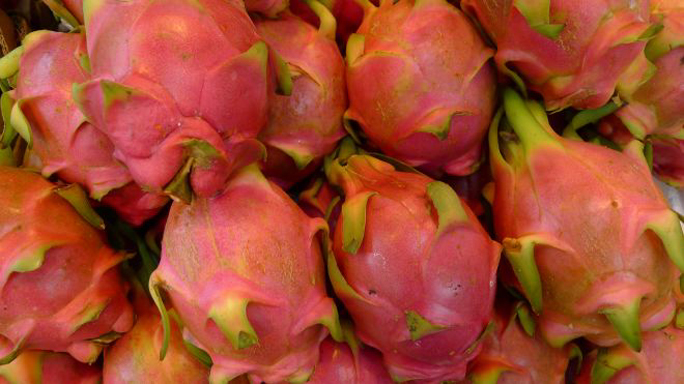Dragon Fruit Medicine Hunter
Not only does it look extraterrestrial, but it also has the name Pitaya, which is certainly strange. The thick, fleshy protrusions off the skin suggest that perhaps it can swim, or maybe even fly. Over the past couple of years it has shown up in grocery stores, seemingly out of no where. What in the world is that thing? Most people don’t know what it is or what to do with it. And the name? Dragon fruit! How exotic.
Native to Mexico, Central and South Americas, dragon fruit is widely cultivated and highly popular in Southeast Asia. There, it is quite common and found in virtually every market in season. I first encountered this strange and luscious edible plant at a gas stop a few hours out of Kuala Lumpur at a fruit stand. I stood staring at the display for a couple of minutes before giving it a try. The one I ate was deep reddish purple inside. But the inside flesh of other cultivars of dragon fruit might be white, yellow or blue. Mysterious. After cutting the fruit into quarters, I bit in deeply. Instantly I was swooning from the mildly fragrant, juicy consistency. Dragon fruit is really something.
Recently at a hotel breakfast buffet in Hong Kong I took a second swipe at dragon fruit and was every bit as impressed as the first time, though my experience was tamer than standing out in the hot Malaysian sun with juice dripping down my fingers. Once you cut through the somewhat odd outer skin, the interior appears shot with poppy seeds. The tiny little black seeds are slightly crunchy, and the delicate flesh has one of those tastes that lingers in the mind long after the fruit is gone.
So what is this mysterious new food that is appearing in more supermarkets? Dragon fruit comes from a cactus. The plant is low in calories, a source of beneficial dietary fiber, and rich in vitamin C, a few of the B vitamins and antioxidants. Dragon fruit is a delightful addition to the diet, offering an entirely new flavor reminiscent of some melons and a good source of vegetarian omega 3 fatty acids.
You can eat all the dragon fruit you want with impunity. It’s never going to put on pounds, and because it’s low in sugar, it won’t mess up your blood sugar either. Except for the fact that you might need to dig one or two seeds out from between your teeth with a toothpick when you’re done eating, dragon fruit is near perfect.
Of the cultivars of dragon fruit, the one with the reddish interior is the most nutritious. This type is unusually high in very potent antioxidants, including the purplish anthocyanins, and catechins and epicatechins, which are also found in green tea. While all the types of dragon fruit are good for you, the red ones also impart very significant protection to the cells in the body and are also anti-inflammatory. They are also rich in lycopene, which is beneficial for the prostate.
In today’s supermarkets, fruits, vegetables and various foods previously undreamed of now occupy the shelves, right alongside the familiar staples of our childhoods. In this mix, dragon fruit appears, offering a look that provokes conversation, flavor that isn’t unparalleled by other foods, and health benefits galore. Try dragon fruit for yourself, and you’ll likely become a convert.


